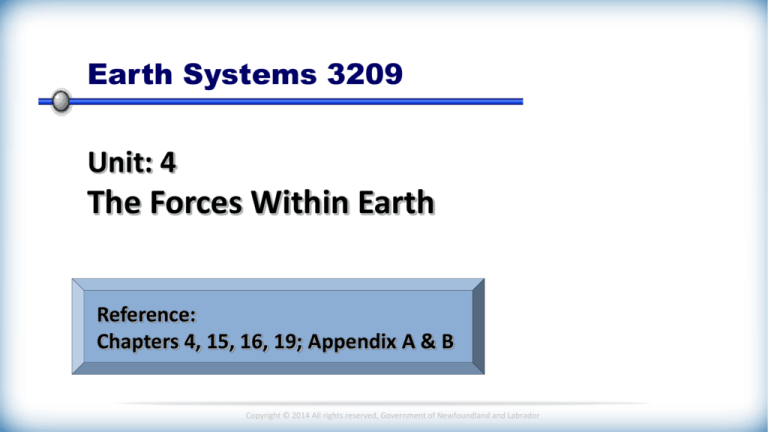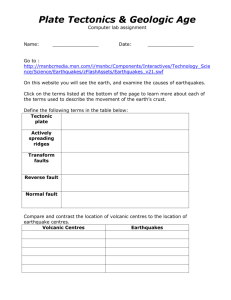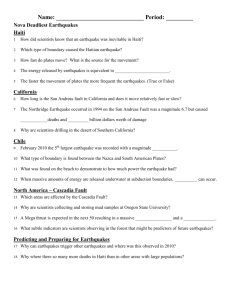
Earth Systems 3209
Unit: 4
The Forces Within Earth
Reference:
Chapters 4, 15, 16, 19; Appendix A & B
Copyright © 2014 All rights reserved, Government of Newfoundland and Labrador
Unit 4:
Topic 4.2
Causes and Locations of Earthquakes
Focus on . . .
describing the causes of an earthquake.
discussing the relationship between earthquakes and
the elastic rebound theory.
identifying the environments where earthquakes occur
and relating them to locations along plate boundaries .
Copyright © 2014 All rights reserved, Government of Newfoundland and Labrador
Cause of Earthquakes
What is an Earthquake?
An earthquake is the vibration of Earth produced by the
sudden, rapid release of energy.
Seismology
When an earthquake occurs, the elastic energy is released
and sends out vibrations that travel throughout the Earth.
These vibrations are called seismic waves. The study of how
seismic waves behave within Earth is called seismology.
Text Reference:
Pages 441-443
Copyright © 2014 All rights reserved, Government of Newfoundland and Labrador
Focus and Epicenter
Earthquake Focus and Epicenter?
Focus:
The exact location within Earth were seismic waves originate
and are generated by sudden release of stored elastic energy.
Most often located on a pre-existing fault.
Epicenter
The point on the surface of Earth directly above the focus.
Earth’s Surface
Epicenter
Fault Plane
Focus
Copyright © 2014 All rights reserved, Government of Newfoundland and Labrador
Cause of Earthquakes
Earthquakes occur when energy stored in elastically strained
rocks is suddenly released.
This release of energy causes intense ground shaking in the
area near the source of the earthquake (Focus) and sends
waves of elastic energy, called seismic waves, in all directions
throughout Earth.
Earthquakes can be generated by bomb blasts, volcanic
eruptions, and sudden slippage along faults.
Earthquakes are definitely a geologic hazard for people living in
earthquake regions, but the seismic waves generated by
earthquakes are invaluable for studying the interior of the Earth.
Copyright © 2014 All rights reserved, Government of Newfoundland and Labrador
Cause of Earthquakes
How does an Earthquakes Originate?
Movement in areas along the fault plane stops (fault sticks).
Elastic energy is stored in the rock as the rock becomes
deformed and bends, much like a bent stick.
When the elastic strain built up along the fault exceeds the
elastic limit, the rock will break or slip at its weakest point
which we call the the focus.
This slippage along the fault allows the rock to “snap back”
and the vibrations sends out waves of energy in all directions
called seismic waves, or earthquake waves.
The springing back of the rock is called “elastic rebound”.
Copyright © 2014 All rights reserved, Government of Newfoundland and Labrador
Elastic Rebound Theory
The mechanism that cause earthquakes was not understood
until H. F. Reid proposed his idea of “Elastic rebound.”
Reid suggested that most natural earthquakes are caused by
sudden slippage along a fault zone.
Original position
of rocks before
any strain
Copyright © 2014 All rights reserved, Government of Newfoundland and Labrador
Elastic Rebound Theory
The elastic rebound theory suggests that if movement
along a fault gets stuck, elastic strain energy builds up
deforming rocks on either side of the fault.
Fault
A feature across the fault
bends as the rocks on
both sides of the fault
pushes in opposite
directions and elastic
strain builds up
Copyright © 2014 All rights reserved, Government of Newfoundland and Labrador
Elastic Rebound Theory
When the rocks along the fault can no longer hold the strain
slippage occurs at the weakest point along a fault (focus)
which causes rock to start moving on both sides of the fault.
Energy is released in all directions causing an earthquake.
Fault
The fault ruptures
releasing elastic
energy
Energy Released
Copyright © 2014 All rights reserved, Government of Newfoundland and Labrador
Elastic Rebound Theory
When the elastic strain is released the rocks on
both sides of the fault will “snap-back” to their
unstrained positions.
Fault
Elastic strain on
rocks released
Copyright © 2014 All rights reserved, Government of Newfoundland and Labrador
Location of Earthquakes
Earthquake Belts:
About 95% of the energy released by
earthquakes originate in a few narrow
zones that wind around the globe.
The greatest concentration of earthquakes
are located along the outer edge of the
Pacific Ocean in an area known as the
“Pacific Ring of Fire.”
Copyright © 2014 All rights reserved, Government of Newfoundland and Labrador
Location of Earthquakes
Earthquake Depths:
Seismic records show that earthquakes originate at
depths ranging from 5km to 700km and can be classified
according to depth of occurrence.
90% of all earthquakes occur at depths less than 100km.
Depths are classified as follows:
1) Shallow Focus (less than 70 km)
2) Intermediate Focus (70km to 300km)
3) Deep Focus (greater than 300km)
Copyright © 2014 All rights reserved, Government of Newfoundland and Labrador
Text Reference
Pages 447-451
Location of Earthquakes
Earthquake Depths:
Earthquakes can occur at any of the three plate boundaries.
Divergent Plate Boundary:
Earthquakes generated along
oceanic ridge systems always
have a shallow focus and are
not very strong.
Example: Mid Atlantic Ridge.
Copyright © 2014 All rights reserved, Government of Newfoundland and Labrador
Location of Earthquakes
Earthquake Depths:
Earthquakes can occur at any of the three plate boundaries.
Transform Plate Boundary:
Earthquakes generated along
transform plate boundaries, have
shallow and very powerful earthquakes.
Example: San Andreas Fault.
Copyright © 2014 All rights reserved, Government of Newfoundland and Labrador
Location of Earthquakes
Earthquake Depths:
Earthquakes can occur at any of the three plate boundaries.
Convergent Plate Boundary:
Earthquakes generated along convergent plate
boundaries range in depths and are very powerful.
Focus depth increases with distance away form
the trench ranging from shallow to deep. This
earthquake zone is called the Wadati-Benioff Zone.
Example: Japan Trench.
Copyright © 2014 All rights reserved, Government of Newfoundland and Labrador
Example 1:
The most common cause of earthquakes is;
(A)
(B)
(C)
(D)
the collapse of limestone caverns on the borders of continents.
the increasing stress between tectonic plates.
energy released by volcanic eruptions.
the gravitational pull of the moon and sun on the continental
landmasses.
Copyright © 2014 All rights reserved, Government of Newfoundland and Labrador
Example 2:
At which of the following locations would you least
likely find earthquakes?
(A)
(B)
(C)
(D)
transform boundary
divergent boundary
subduction zone
nuclear testing site
Copyright © 2014 All rights reserved, Government of Newfoundland and Labrador
Your Turn . . .
Take the time and complete the following questions . . .
(Solutions to follow)
Question:
Earthquakes commonly occur at plate boundaries,
with reference to elastic rebound, what causes an
earthquake?
Copyright © 2014 All rights reserved, Government of Newfoundland and Labrador
Solutions . . .
Question:
Earthquakes commonly occur at plate boundaries, with reference to
elastic rebound, what causes an earthquake?
Answer:
There is a build up of stress (energy) within the
tectonic plates, where it reaches the elastic limit. The
plates then rupture (snap) and the stored energy is
released. Plates then move (snap) back to
unstressed positions releasing the stored energy as
seismic waves. This is what we call an earthquake.
Copyright © 2014 All rights reserved, Government of Newfoundland and Labrador
Summary . . .
Overview of Points covered:
Elastic rebound can explain the cause of earthquakes
Earthquakes are limited to narrow areas around the globe.
Example: Pacific Ring of Fire
Earthquakes exist at all plate boundaries.
Earthquake depths vary from shallow, intermediate, to deep.
Copyright © 2014 All rights reserved, Government of Newfoundland and Labrador










